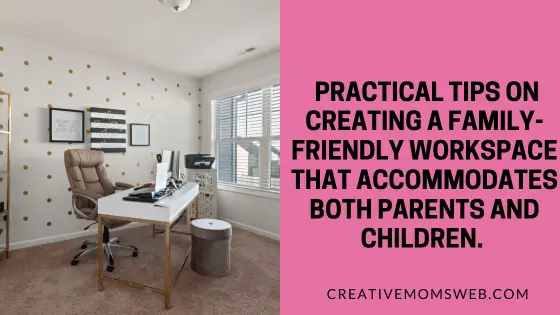Balancing work and family life has always been a challenge, but the rise of remote work has brought this issue to the forefront for many families. Designing a workspace that accommodates both parents and children can help to create a harmonious environment where everyone can thrive. Here are some practical tips to help you set up a family-friendly workspace that meets the needs of both adults and kids.

Practical tips on creating a Family-Friendly Workspace
1. Define Separate Zones
Creating distinct areas for work and play is crucial. This helps establish boundaries and minimizes distractions. Here’s how:
- Work Zone: Set up a dedicated area for your work, ideally in a quiet part of the house. This space should include your desk, chair, computer, and other work-related materials.
- Play Zone: Designate a separate area for your children’s activities. This could be a corner of the room with their toys, books, and art supplies.
2. Child-Friendly Workstations
If your children are old enough to engage in educational activities or need a place to do homework, set up a small workstation for them. This can include:
- A child-sized desk and chair
- Storage for school supplies
- A bulletin board for schedules and artwork
3. Invest in Storage Solutions
Clutter can be a significant source of stress and distraction. Invest in storage solutions that keep both your work materials and your children’s items organized. Consider:
4. Use Noise Management Techniques
Noise can be a major disruptor in a shared space. Here are some ways to manage it:
- Noise-Canceling Headphones: For parents who need to concentrate or attend virtual meetings.
- White Noise Machines: These can help drown out background noise.
- Quiet Activities: Encourage children to engage in quiet activities such as reading, drawing, or puzzles during critical work times.
5. Flexible Furniture
Furniture that serves multiple purposes can save space and money. Consider:
- Adjustable desks that can be used by both adults and children.
- Foldable tables and chairs that can be easily stored when not in use.
- Sofas that double as guest beds or reading nooks.
6. Safety First
Ensure the workspace is safe for children, especially if they are very young. This includes:
- Securing heavy furniture to the wall
- Covering electrical outlets
- Keeping small or hazardous items out of reach
7. Create a Routine
A routine helps establish expectations and creates a sense of normalcy. Consider:
- Setting specific work hours and break times
- Creating a daily schedule that includes both work and play activities
- Using visual schedules for younger children to help them understand the flow of the day
Read: Routine for work-from-home mom
8. Encourage Independence
Encourage your children to play independently or work on their homework without constant supervision. This fosters self-reliance and gives you more uninterrupted work time. Some strategies include:
- Providing a variety of engaging and age-appropriate activities
- Setting up a reward system for completing tasks independently
- Teaching them to resolve minor issues on their own
9. Incorporate Nature
Bringing elements of nature into your workspace can have a calming effect and improve overall well-being. Consider:
- Adding plants to your workspace
- Ensuring there is plenty of natural light
- Setting up the workspace near a window with a view
10. Take Breaks Together
Taking regular breaks is essential for maintaining productivity and mental health. Use this time to connect with your children. Activities could include:
- Going for a walk or playing outside
- Doing a quick craft project
- Sharing a healthy snack
Conclusion
Creating a workspace that accommodates both parents and children requires thoughtful planning and flexibility. By defining separate zones, investing in storage solutions, managing noise, and fostering a routine, you can create an environment where everyone can work and play effectively. Remember, the goal is to create a balanced space that supports both productivity and family bonding. With these tips, you can transform your home into a family-friendly workspace that meets everyone’s needs.
